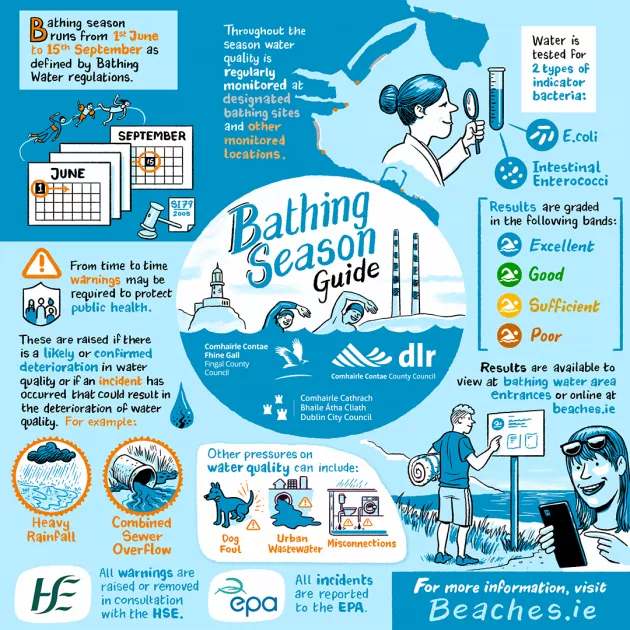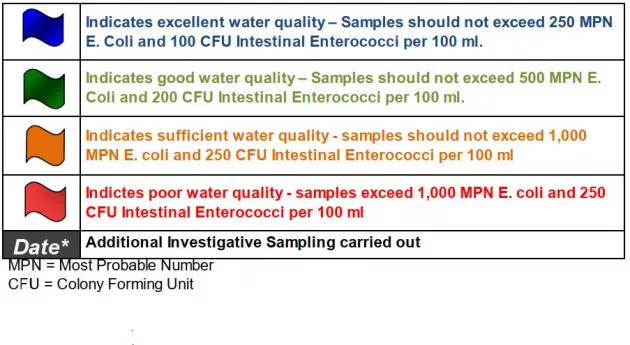Beaches and Bathing Water Quality
Dublin City Council monitors bathing water quality at its three designated bathing waters namely Dollymount Strand, Sandymount Strand and Half Moon. Monitoring is also carried out at non-designated bathing waters including Merrion Strand, Shelly Banks and North Bull Wall.
The bathing season runs from 1st June to September 15th. Dublin City Council exceeds the regulatory requirement and samples on at least twenty occasions during the bathing season and fortnightly thereafter. The 2025 bathing season sampling schedule is available here with the results below or on www.beaches.ie
The 2024 season marked Half Moon's first year as a designated bathing location. Based on sampling conducted during that season, it has been classified as having Excellent Bathing water quality. Dollymount Strand is classified as having Good bathing water. Sandymount strand is classified as having Poor bathing bathing water. A swim restriction will remain in place at Sandymount Strand for this season.
Dublin City Council is committed to continuing efforts to maintain and improve the water quality of its bathing water and remains dedicated to ensuring the safety and enjoyment of all visitors to its beaches.

Bathing Water Quality
Dublin City Council monitors bathing water quality at its three designated bathing waters namely Dollymount Strand, Sandymount Strand and Half Moon. Merrion Strand was declassified as a designated bathing water from the 1st June 2020. Sandymount Strand was classified as having Poor Water Quality in both 2024 and 2025, based on the water quality results from the preceding four year periods. Consequently, a Bathing Prohibition will apply at the bathing water for the 2025 bathing season. Half Moon was newly identified as a designated bathing water in 2024 and has now been classified in 2025 with Excellent bathing water quality. It is a welcome addition to Dublin City Council’s list of identified bathing sites.
The bathing season runs from 1st June to September 15th, with pre-season sampling commencing in mid-May. In addition, Dublin City Council also undertakes water quality monitoring at undesignated bathing areas, namely; Merrion Strand, Shelley Banks beach, as well as the North Bull Wall. At least twenty samples are taken from each location during the bathing season. Furthermore, Dublin City Council continue to monitor water quality throughout the year, outside of the bathing season on a fortnightly basis.
Assessment of water quality involves analysis of two types of bacteria (E coli and Intestinal Enterococci) which may be present in the water. These bacteria are indicators of water quality. The results are categorised in accordance with Bathing Water Regulations, 2008. Bathing water quality is classified as ‘excellent’, ‘good’, ‘sufficient’ or ‘poor’ and these classifications are based on the concentrations of the two bacteria species detected in samples of bathing water.

Temporary Bathing Prohibitions, Advisory and Prior Warning Notices
To protect bather health, it may be necessary to advise against or prohibit bathing at Dublin City Council’s bathing areas. Bathing water quality is particularly impacted by weather conditions, with factors such as rainfall amount and intensity, temperature, sunlight and tidal conditions being the main influences. Faecal matter from dogs and birds on a beach can significantly impact on water quality as can temporary overflows from urban drainage infrastructure.
Additionally, if Dublin City Council receives information which indicates a risk of deterioration in bathing water quality, a precautionary advisory or prohibition notice may be issued. Examples of such include a prediction of an extreme weather event or an exceedance/non-compliance from the Wastewater Treatment Works (i.e. effluent quality fails to meet the conditions of discharge as set out in the Wastewater Discharge Licence issued by the EPA for the Works).
The Environmental Protection Agency (EPA) and Health Service Executive (HSE) have established a protocol outlining various recommended actions to be taken by local authorities where, levels of bacteria in the bathing water exceed the satisfactory standard. In such circumstances, the local authority consults with the HSE in the first instance before proceeding with an agreed action. The public are informed of the short term pollution event through social media, web notifications and by erecting temporary signage at the locations affected. The website www.beaches.ie shares the latest information on national bathing water quality. Swim restrictions and annual water quality ratings can be found here. In addition, Dublin City Council operates a series of electronic signs on Dollymount and Sandymount Strands which notify the public when it is unsafe to swim. Once the event has passed and water quality returned to a satisfactory standard, the public are immediately informed.
The '48 hour rule,' as promoted by beaches.ie , advises the public to avoid swimming or other water activities for at least 48 hours after heavy rainfall. This precaution is due to the increased risk of pollution from stormwater runoff contamination waterways. Members of the public are encourages to follow this guidance to protect their health.
Further information on real time water temperature, wave height and wind direction can be found on the following external website: https://cilpublic.cil.ie/metocean/